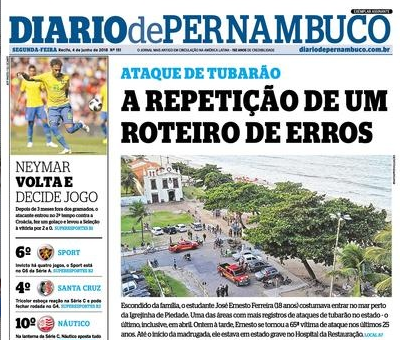
A country marked by high media concentration, Brazil has seen its journalism market diversify in the last decade with the arrival of international organizations.
With the purpose of "optimizing resources and managing inventory more efficiently," the newspaper El Nacional of Venezuela will stop circulating "temporarily" on Mondays and Saturdays starting on Aug. 20, the publication reported Aug. 19 in a short message entitled “Cinco días por la libertad” (Five days for freedom).

Founded in 1825, Brazil’s Diario de Pernambuco newspaper faces a financial crisis that has cut a third of its newsroom and keeps its employees on edge in the face of delays in the payment of salaries and suspense over the daily’s future.
At the end of 2001, Argentina's political and economic crisis was the main theme in Latin American news coverage. The economic recession that culminated in intense popular protests and the resignation of then-president Fernando de la Rúa also fostered a peculiar phenomenon: that of companies recuperated by their workers.
In a move contrary to global trends in journalism, the traditional newspaper Jornal do Brasil (JB) returned to the newsstands on Feb. 25 after eight years after it closed its print edition and became a purely digital media outlet.
Folha de S. Paulo, the newspaper with the largest circulation in Brazil, surprised the news industry on Feb. 8 by announcing it would stop publishing content on Facebook as its directors believe that recent changes in the social network’s algorithm diminish the visibility of professional journalism and favor the spread of false content. The newspaper’s executive editor, Sérgio Dávila, says there are reports of similar moves in other newsrooms.
The Permanent Commission of the Peruvian Congress is evaluating a new bill that attempts to restrict state advertising only to national media and social networks. Private media would no longer receive state advertising.
Cuban digital media site 14ymedio is betting on a new membership program for readers to ensure its independence and increase engagement.
Against the almost total domination of the digital advertising market by platforms such as Facebook and Google, some of the most traditional newspapers in Argentina, Brazil, Colombia and Mexico– the latter being the pioneer in Latin America– have decided to adopt paywalls as a business model in their search for greater financial sustainability.
Brazil’s Grupo Globo, one of the world’s largest media conglomerates, announced changes to the direction and operation of its two main print outlets, newspaper O Globo and weekly magazine Época on Oct. 23. The changes point to an attempt to renew the media organizations in the context of the newspaper’s digital expansion and the decreased print circulation of both publications.
With the objective of sharing experiences and “getting your hands dirty,” the Escola de Dados (School of Data) is organizing the second edition of the pioneering Brazilian Conference on Data Journalism and Digital Methods, Coda.Br, on Nov. 25 and 26 in São Paulo. The idea is to bring together professionals from various fields to discuss common issues such as algorithmic responsibility, machine learning and privacy. Registration is open.
At a time when most journalism is moving from print to digital, Peruvian investigative journalism site Ojo Público is doing the opposite. At least partly.